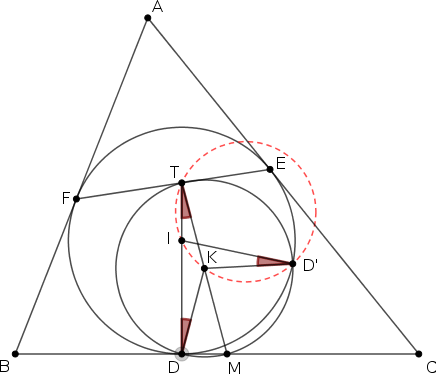 Problem B. 5025. (April 2019)
Problem B. 5025. (April 2019)
B. 5025. The inscribed circle of triangle \(\displaystyle ABC\) is centred at \(\displaystyle I\), and touches sides \(\displaystyle BC\), \(\displaystyle CA\) and \(\displaystyle AB\) at points \(\displaystyle D\), \(\displaystyle E\) and \(\displaystyle F\), respectively. Let \(\displaystyle M\) be an arbitrary point in the interior of side \(\displaystyle BC\), different from \(\displaystyle D\). Let the lines \(\displaystyle DI\) and \(\displaystyle EF\) intersect at \(\displaystyle T\), and let \(\displaystyle K\) denote the midpoint of line segment \(\displaystyle MT\). Prove that the circles \(\displaystyle DEF\), \(\displaystyle TDM\) and \(\displaystyle KIT\) are concurrent.
Proposed by M. Agazade, Azerbaijan
(5 pont)
Deadline expired on May 10, 2019.
Sorry, the solution is available only in Hungarian. Google translation
Megoldás. A \(\displaystyle BMC\) egyenes a \(\displaystyle D\) pontban érinti a beírt kört, ezért \(\displaystyle TDM\measuredangle=IDM\measuredangle=90^\circ\). A Thalész-tétel megfordítása szerint a \(\displaystyle TDM\) derékszögű háromszög köré írt kör középpontja a \(\displaystyle TM\) átfogó felezőpontja, vagyis \(\displaystyle K\).
Legyen \(\displaystyle D\) tükörképe az \(\displaystyle IK\) egyenesre \(\displaystyle D'\). Az \(\displaystyle IK\) egyenes a \(\displaystyle D\) ponton átmenő \(\displaystyle DEF\) és \(\displaystyle TDM\) körök centrálisa, ezért mindkét kör átmegy a \(\displaystyle D'\) ponton. Tehát a feladat megoldásához elegendő az igazolnunk, hogy a \(\displaystyle KIT\) kör is átmegy \(\displaystyle D'\)-n.

A \(\displaystyle TDK\) háromszög egyenlő szárú, mert \(\displaystyle KT\) és \(\displaystyle KD\) a beírt kör sugarai, ezért
\(\displaystyle ID'K\measuredangle = KDI\measuredangle = KDT\measuredangle = DTK\measuredangle = ITK\measuredangle. \)
Mivel \(\displaystyle ID'K\measuredangle = ITK\measuredangle\), és a szögek irányítása is azonos (mindkettő a \(\displaystyle KDT\measuredangle\) tükörképe), a kerületi szögek tételének megfordítása miatt \(\displaystyle D'\) rajta van a \(\displaystyle KIT\) körön is.
Statistics:
28 students sent a solution. 5 points: Baski Bence, Beke Csongor, Bencsik Ádám, Csaplár Viktor, Fekete Richárd, Füredi Erik Benjámin, Geretovszky Anna, Győrffi Ádám György, Hámori Janka, Hegedűs Dániel, Jánosik Áron, Kerekes Boldizsár, Kitschner Bernadett, Kovács 129 Tamás, Nagy 551 Levente, Nagy Nándor, Nguyen Bich Diep, Osztényi József, Rareș Polenciuc, Sebestyén Pál Botond, Stomfai Gergely, Szabó 991 Kornél, Tiderenczl Dániel, Tóth 827 Balázs, Várkonyi Zsombor, Velich Nóra, Weisz Máté, Zsigri Bálint.
Problems in Mathematics of KöMaL, April 2019
